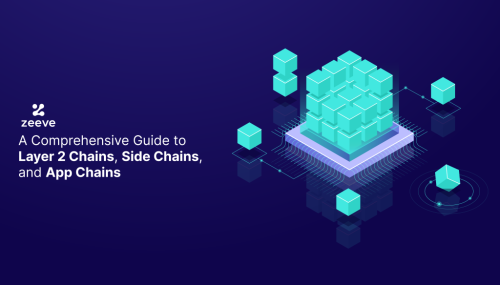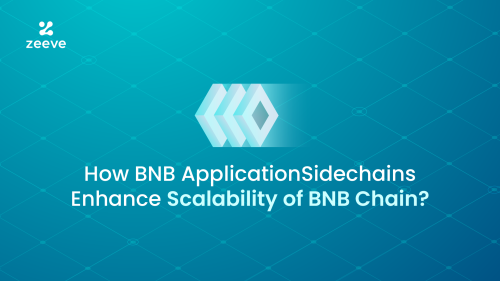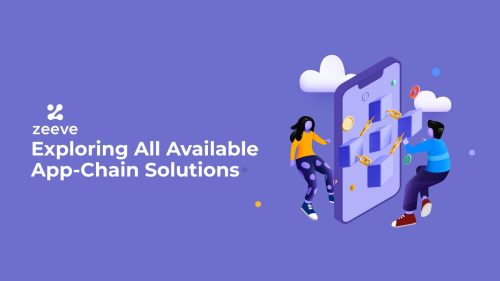
Comprehensive Guide on Layer 2, Sidechains and App Chains
Mostly, the organizations embracing blockchain deploy the architectures built on existing popular blockchain networks such as Ethereum or Bitcoin. However, traditional blockchains or monolithic blockchains are suffering from the issue of increased users. At the end of the day, there is a limit to the number of transactions.
A blockchain network is the main chain, and transactions that take place on it are called “on-chain.” However, transactions that do not take place on it are called “off-chain.” Additionally, relying completely on the “on-chain,” there is either the problem of decentralization or scalability. Commonly known as the scalability trilemma.
The sidechains, app chains, and layer 2 do similar work as that of the main network (Layer1), and, at the same time, it has low fees.
These different layers are called scaling solutions. The scaling solutions take away the stress from the main blockchain. In this blog, let’s uncover the basics of Layer2, sidechains, and app chains.
Public & Private Chain
The public chain is also known as the layer1 (L1) blockchain; everyone on the system can see the transactions. It supports decentralization and has peer-to-peer transactions. Although public blockchains are great for self-governance, the network has high energy consumption. This further fuels the high transaction costs.
The private chain is permissioned and has a network administrator. The private chain is mainly built for a specific application. Users can participate in the on-chain activities only if they get privacy. The users on the system are verified on a private blockchain. The speed on the private chain is better but isn’t widely suitable.
The Various Scalability Solutions
The blockchain trilemma moves around decentralization, security, and scalability. While controlling decentralization and security, the scalability of the network has to suffer. Mainly, the problem of scalability on public blockchain affects the transaction throughput and latency. Some of the scalability solutions are given below.

The three most popular scalability solutions we will understand in this blog are Layer 2, sidechains, and app chains.
Layer 2
Scalability is a significant struggle in the blockchain world. By solving the scalability issue, the networks can solve two problems — transaction speed and transaction throughput. Layer 1 is the main blockchain, for example, Ethereum. Layer 2 adopts the security of layer 1 — it is basically a nested blockchain. It uses the framework of the main blockchain, and the transactions occur on the interconnected network of secondary chains.
Working and Performance of Layer 2
Layer 2 (L2) is a separate blockchain that extends from mainnet and regularly communicates with L1. On the L1, it submits bundles of information. Therefore, the layer handles data availability, decentralization, and security. Layer 2 manages the scaling, handles the transactions, and shares finalized proofs with L1.
The two most popular examples of the Layer 2 are Ethereum Plasma and Bitcoin Lightning Network. Layer 2 is also called an off-chain scaling solution which further includes:
- State channels: The channels allow P2P channels, and there can be an unlimited amount of transactions. However, the participants on state chains are fixed.
- Rollups: The rollups are categorized into two types the optimistic rollups and the zero-knowledge proofs. The rollups execute the transactions off-chain and add them to the network later.
- Plasma: The plasma is similar to the para chains on the Polkadot. One of the chains’ primary roles is to take transactions from L1 and reduce their burden.
The benefits of Layer 2
- Lower fees: The transaction output is slow, and thus the demand on the main chain is less. Due to this, layer 2 has a low transaction fee. Thus, it is cost-effective.
- Security of L1: Layer 2 shares the load on L1, which leads to better transaction throughput. Furthermore, there is an improvement in scalability.
- Many Use Cases: Layer 2 is built on Layer 1, and therefore it is compatible with other systems. There is no need to modify the underlying protocol.
- Functionality: The L2 blockchains can be used to add additional functionality, such as various privacy features and atomic swaps.
Side Chains
A side chain is a smaller version of the main net. The L2 requires an underlying protocol. However, the side chain is independent of the main chain and has its own security. A side chain consists of a public block explorer and coin backing up nodes. It allows new users to establish nodes in order to correspond with the main chain.
Side chains have their own consensus protocol. Sidechains are connected to L1 via a two-way bridge. For example, the Liquid Network One more is the Plasma network which is a part of the Ethereum Network.
Working & Performance of Sidechains
Depending on the application, the sidechain can be public or private. Usually, an individual or organization operates the nodes of the side chain and assists with its security. It is known as the two-way peg system, which enables communication with the L1.
The two-way peg is helpful as one can transfer assets between the main chain and the sidechain. The rules and regulations on sidechains are similar to that of L1 and the chains run parallel to the mainchain.
Benefits
- Customization: Since the app chain is different from the main network, the side chain has its own set of unique rules and protocols. The app chains can be customized for different use cases.
- Experimentation: There isn’t any need to disrupt the mainnet to test new ideas. Since sidechain activities do not affect the main chain, they can be used to test new features.
- Security: The side chains can allow the off-chain execution of high-value transaction. By doing so, it helps lower the risk of main chain transactions being compromised. Diversification becomes effortless on the network as access to assets from other blockchains becomes easier.
App Chains
App Chains are the application-specific blockchain. The chain is built in a way that it supports applications that have a specific or, say, one use case. There are multiple layers of permissions, fee tokens, security, etc. One of the notable examples is Bitcoin Gold, which specifically works for digital gold. Additionally, Cosmos SDK is one such open-source framework that allows the sovereignty of the blockchain network. The app chains have mainly enterprise-based features.
Working & Performance of App Chains
The UX of app chains has improved substantially, the reason being low transaction costs. One more reason is that latency is low. The dapps have tough competition among themselves. There may be one popular dapp that takes the space and sadly increases transaction costs. While sidechains and the L2 chains execute every kind of asset exchange and transaction.
The app chains consider the validators from the main blockchain. App chains support the deployment of dapps by having their own token for staking. Therefore, there is no competition with the main blockchain. For instance, Polygon is a sidechain. While Polygon edge is an app chain specifically designed for private networks.
Benefits
- Futuristic: The app chains are purpose-built and are known to represent the future of blockchain because of the application-specific use cases.
- Modular: The modification of app chains is hassle-free. There are some of the core modules which can be forked or can be expanded.
- Ownership: Ownership on an app chain also improves as there are less number of users for a specific application.
- Autonomy: The app chains provide autonomy as enterprises can opt between the PoS or PoA consensus. The governance is isolated from other use cases.

Final Thoughts
We understood in the blog that Layer 2 provides scalability — an extension of the existing blockchain. Sidechain is a completely separate blockchain linked to a main blockchain. While the app chain, the application-specific blockchain has a closed-off infrastructure. Therefore, it is suitable for a specific function only. Mainly all of these architectures solve the main issue of scalability. However, mainstream adoption will happen when the deployment happens as per the use cases.
Blockchain technology will revolutionize the way companies work by ruling out inefficiencies, intermediaries, and centralized information. There will be data security and privacy if the public and private organizations opt for blockchain infrastructure.
Partner with Zeeve
You are anticipating which blockchain architecture will go well with your organization. Our team can help you deploy the most appropriate architecture for your company’s use cases. Other than the option of choosing an architecture, we are one of the platforms that offer bring your own cloud (BYOC) as a service. With a clientele base of more than 12000 blockchain startups, enterprises, and developers. We enable users to access the CICD automation, node monitoring, and GUI dashboard.
We keep sharing more about our work on Twitter, and you can also join us on Telegram. Need to discuss your project? Get on a call with Zeeve.







Responses